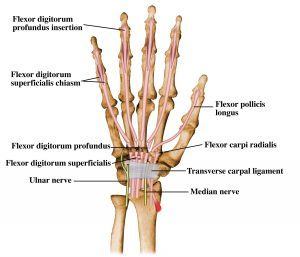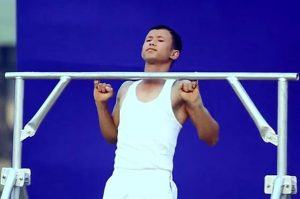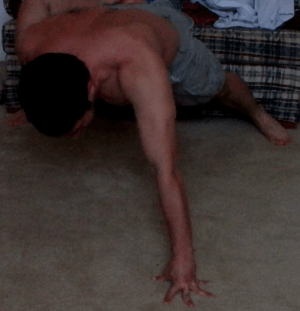Everyone (which is to say, everybody that isn’t a complete novice) knows that weight training is something done in small incremental increases over a period of time. You start off with low weights, and gradually work up to higher and higher weights. That’s pretty obvious.
What isn’t as obvious is that calisthenics have their own version of this, a tactic so fundamental to advanced calisthenics that it was alluded to multiple times in my Convict Conditioning series of articles, but never explicitly delineated. A tactic that I have dubbed declining calisthenic loads.
What Is It?
Essentially, where weightlifting requires you to add small increments of weight in units of 5 or 10, calisthenic unloading requires you to decrease the weight born on your limbs as you do moves such as the one handed pushup or one-handed pullup.

An old reliable picture of yours truly
While you will find variations of this in all sorts of calisthenic and gymnastic training regimens, I am not aware of anybody giving a proper name to it. Thus I take full credit for being the first to do so.
How does it work?
It depends on the exercise that is being used at the moment, but each of method of declining loads involves gradually removing a limb from labor (note: do not LITERALLY remove your limb, idiot). And as luck would have it, the human body already comes sub-divided (to borrow a musical term) into smaller and smaller units that can be gradually removed, forcing the remaining units to work harder. Those units are of course the phalanges-the fingers and toes-and the various other tarsal and carpal bones that can be nullified in the midst of calisthenic exercise.

Those who have read Convict Conditioning are likely aware of this concept already—indeed, Paul Wade’s discussion of “hand and a half” pushups or “basketball squats” are the fundamentals of this idea, removing the entire hand or foot from the equation and forcing the other podial to labor twice as hard.
But just as musicians will repeatedly subdivide a bar of music to get the proper count and rhythm, and barbell manufacturers produce 1.25 pound plates, you too can subdivide calisthenic exercise—by using musicians will repeatedly subdivide a bar of music to get the proper count and rhythm, and barbell manufacturers produce 1.25 pound plates, you too can subdivide calisthenic exercise—by using your fingers.
Take, for example, the one-handed pull-up: A very difficult exercise indeed, and one that probably provided me with the most difficulty in the convict conditioning curriculum. A way of working up to the true one-handed pull-up that I discovered was to hang with the fingers of one hand.

Beginning with removing the thumb (the strongest digit), you hang with the four remaining fingers, and then do pull-ups with that. And from there you release the pinky finger and do pull-ups. Then remove the ring finger, and so forth until you are using solely the two strongest fingers beyond the thumb, the index and middle finger. Once you’ve successfully done this, you can do pull-ups with just the index finger. And then move onto the other fingers.
The effectiveness of this method is that you can combine fingers based on your level of strength: Knowing that the index and middle fingers are the strongest, should you be struggling to use only the middle finger, you can use the middle and ring or middle and pinky finger as a stop gap.
Similarly, you can utilize any other combination until you are doing pull-ups with just the pinky finger (combined with a fully utilized opposite hand of course). And once you’ve mastered that, the actual one-handed pull-up cannot be too far behind.
If you are struggling with the one handed pushup, you will of course use the “hand and a half basketball” method. And if you can’t cross that gap into the true one-handed pushup…you guessed it, you use the finger method!
Personally speaking, I found that once I had gotten down to using one index finger on the ball, I was ready to do the one-handed pushup. And it is likely many of you won’t even need to do this.
However, where I found this method to be the most useful was in the one-handed fingertip pushup

Gradually removing fingers from the opposite hand into the true finger-tip pushup (With the aid of the medicine ball/basketball) was probably the most useful technique I used in achieving the true one-handed fingertip pushup.
Undoubtedly one could use this for even more calisthenic techniques such as the handstand pushup…but I will admit I have yet to achieve the two handed fingertip handstand pushup, to say nothing of the nigh-mythical single-armed variant.
Regardless of my failure to perform a skill that most people couldn’t imagine…I have still given you the tools to achieve slightly more believable bodyweight skills, in this and past articles. Go forth and use them.
Read More: Two Do-It-Yourself Methods For Training Your Forearms
To me, the pistol is the most difficult exercise in the Convict Conditioning regiment. What would you recommend to a guy with long limbs when progressing to the single legged squat, when even closed leg squat is extremely difficult ?.. Although spinal and neck stretches helped a lot with squat balance, so I will admit Convict Conditioning might be the greatest fitness book in circulation.
I haven’t moved that far along, but I wonder if having resistance bands affixed to your pullup bar might work. It’d reduce the strain on your legs while you grow accustomed to the movement.
I believe that could work. A few other things that worked for me included things like rising out from a seating position in a chair into a half pistol or going into a low pistol squat with a pole nearby for support.
As you get stronger, get a chair with a lower level seat or a low step on a staircase until you can perform the pistol independently.
No goofy basketball required (from the CC book).
That was one of the first Master steps in the series I managed to reach. For the record, I’m a long legged lanky lean bastard myself.
What worked for me was doing ‘ pistol squat negatives’. So you squat down normally. Hamstrings touching calves & both heels flat on the ground as in a full squat.
From this position you’re going to reach out in front with one of your legs (sole facing forward like a front kick & don’t glide your leg along the ground but go above the ground) & mimic how a single leg squat looks at the bottom phase. Hold that position for a few seconds. Return your leg to its original full squat position. Slowly progress over time to where you can rise up from the single squat bottom phase to the regular single leg upright starting phase.
I didn’t bother with the bits that required the use of a basketball in Convict Conditioning.
That basketball fucked me up. I found the rope trick much better.
How are you doing with bridging?
I’m at the wall walking stage. Complete walk down & a complete walk back up to the starting position. Need to work on reps though. It’s slow going.
Hey…I too had difficulties with pistol squats….still do really but not as bad. I found the advice in this article / video to be helpful…that and a lot of patience
I agree that convict conditioning is a great book that everyone who is serious about fitness should read but as much as you can get with bodyweight…and it is significant….I just don’t believe you can realize your potential until you are moving the iron around.
http://www.bodybuilding.com/fun/pistol-perfect-one-legged-squats-and-beyond.html
Once you have the full mobility and functional strength as advised on this book, the free weights take on a whole different level. Whenever I was doing weighted squats or military presses for example, the form wasn’t 100 %, and I could feel I was actually straining certain parts of the body (spine, waist etc.) while working out others…
After Convict Conditioning, every exercise, including sports and martial arts, became much more fluid and holistic for me, ie you can feel your entire body responding positively to say a lift like Clean & Jerk when you have 100 % range of motion, every physical activity works in its most natural, intended form, and to me that is the beauty of this Convict Conditioning book.
This is a perfect understanding, in my opinion, on how to use CC book. I fear that some people, and I am sure you have seen this, hear or see that some exercise is good, CC or 5×5 or HIIT, etc etc etc and then do it to the exclusion of all other things. The goal is a whole body approach, I believe, which incorporates multiple types of training.
I do a lot of HIIT, a lot of bodyweight exercises, a good amount of yoga and a shit ton of lifting. Convict training is an awesome program for sure and for exactly the reasons you state, but I think some people think it is awesome and then forget that everything else exists and that winds up being a net loss. It is basically what the crossfit fags do.
The lifts you mention are quite right by the way. A strict mil press, to me, is the most humbling of all lifts. It looks like it should be easy, but if you keep proper form, keep your knees locked…for me at least….it is a really fucking hard lift to do. I will do 135 for 5 @ between 7.5-8.5 RPE depending on how I am feeling at the moment and I am pretty happy with that. But I see people who are doing it with poor form and I wonder how in the holy hell they aren’t hurting themselves!
As for squats, I no longer do back squats because of the injuries to my spine. I am currently doing goblet squats as a replacement. Fortunately my gym has dumbbells that go up to 225. I want to work on front barbell squats which will give me that motion without loading the weight on my spine, but I have never been able to get the form down so I will need to do a few training sessions before I try. The clean and jerk though….oh boy….the clean and jerk, power clean and all those quick motions from the ground…those lifts that will have your heart thumping like a mad man…..I think that without the core strength and posture, form and rom that you get from a program like CC you will never get them just right.
..
I’ll give it a shot.
There’s a different difficult one for everyone. For me, I simply cannot progress to the one-armed pull-up. I actually tried the method Larsen describes but still got nowhere.
Personally I recommend you try an alternative quad dominant exercise for a while and then try the pistols again later. The main thing is that you can achieve the benefits of the pistol even if you cannot actually achieve the pistol – i.e. improved leg strength, mobility, core strength, balance, etc.
Another thing you can try is holding a rope and use it to maintain your balance. Hopefully with time, you can reduce your dependence on the rope.
Yes, pull ups are slow going for me. I’m stuck at the assisted one arm pull up stage. I wrap a towel around the bar & while its great for building my grip strength, it’s been quite a struggle to move on from there.
That’s where I got stuck until I suffered a chronic shoulder injury. Be careful of that.
Sorry to hear that. Hope it gets better for you. Pull ups seem to be the most complicated of the body weight challenges.
I would say the abs are an essential support muscle group for the correct pull up. Your lower body should be slightly in front of your upper body in the pull up so that unnecessary strain doesn’t load on the shoulders from the natural swinging that might otherwise occur (so you are pulling the bar towards your chest with abs tucked in)…
If you practice using your abs to control the lower body (eg with leg raises or just moving your lower body around in the dead hang position), then the pull up becomes arguably the ultimate compound exercise for your back and arms.
http://www.bodybuilding.com/fun/topicoftheweek23.htm
Good point. Adopting the hollow body position helps with that.
Agreed. Just want to add another point about rolling the shoulders back & locking them just before the upward pull. I have this bad habit of sometimes forgetting to do that.
Thanks for the link, Max. Appreciated.
[(note: do not LITERALLY remove your limb, idiot)
Shoot. Too late…..
Unless it is to remove it from your ass.
american joke detected.
Those “old reliable” pictures of you working out on filthy carpet in front of an ugly plaid couch are truly inspiring.
I like them. Kind of a reminder that you can and should work out wherever you currently find yourself hanging your hat, with what you have available. I’m going to be doing my workouts with bodyweight only in a little hotel room somewhere in Central America this week, for example.
True, but I am beginning to wonder he even looks this fit like this anymore if these old pictures are the best he can show us now.
What are you trying to say? Why wouldn’t he still be fit?
The Naked Warrior.
There’s a good ‘removing one limb’ exercise involving legs I did quite often. The ‘one legged hop’ stair climb.
I grew up in a two story house and as a kid I tried hopping up one legged. I only got up three steps the first time but in a few weeks I was hopping up the entire flight, two steps at a time. I was in 7th grade, about 5’8″, 110 lbs or so and skinny. If you’ve got stairs at home then it’s a great way to cinch a workout into an otherwise daily grind. Don’t waste good stairs if you got em. I hear a lot of old farts cursing stairs. People with stairways in their homes could presumably use the stairs up to 30 times a day if they’re not sedate. 99.9% of stair climbing commuters I see walk up one foot at a time, left-right-left. Try one legged hopping. I skateboarded as a youth too so I was somewhat made of rubber and my ankles quickly developed strength to hop double steps, but at any age the stair hop can improve the ankle strength.
Good idea if you can handle it. I highly doubt my knees could handle the impact, personally.
cool stuff! Going to give it a try. I used to train with a guy who could do those one finger pull-ups. I always thought it was unfair because he was a 5’3 Pilipino guy who weighed like 120 pounds — then I saw him deadlifting 465 for reps and realized that while being smaller was an advantage this little mf’r was really, really freaking strong.